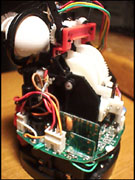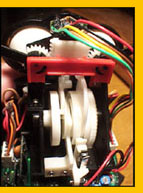Muscles:
Furbies have a single reversible motor, which drives a series of gears and cams which moves his ears, eyes, eyelids, mouth and butt. The cams are all on the same drive shaft, so one full rotation of the shaft will put him through all combinations of motions. His patterns of eye, mouth, ears and butt motions are predetermined by the patterns on the cams. He cannot independently move his eyes from his mouth, for example. However, he does have a separate cam for each major function, so by careful arrangement of the lobes and shapes of the cams, moving a body part separately is possible in a limited fashion by moving the main shaft back and forth in a narrow rotation of the cams.
 Each angular region of the shaft's rotation can be described as combinations of each motion controlled part's state (ie: eyes open, eyes closed, ears up, ears down, mouth open, mouth closed, etc.) By arranging these states on the cams, sequences of animated motion can be achieved by rotating the main shaft forwards and backwards. For example, to dance, he may drive the main shaft back and forth 20 degrees, moving the butt motion cam, but that happens to be a dead spot for the eyeball and ear cams, making his eyes stay open and ears unmoving during the dance. However, the positions cannot be accessed randomly, only sequentially (ie: in order to get to "dance" he may need to spin through "eat", "blink" and "sleep" to get there).
Each angular region of the shaft's rotation can be described as combinations of each motion controlled part's state (ie: eyes open, eyes closed, ears up, ears down, mouth open, mouth closed, etc.) By arranging these states on the cams, sequences of animated motion can be achieved by rotating the main shaft forwards and backwards. For example, to dance, he may drive the main shaft back and forth 20 degrees, moving the butt motion cam, but that happens to be a dead spot for the eyeball and ear cams, making his eyes stay open and ears unmoving during the dance. However, the positions cannot be accessed randomly, only sequentially (ie: in order to get to "dance" he may need to spin through "eat", "blink" and "sleep" to get there).
All of the moving body parts are clutched, spring loaded, or otherwise protected from being obstructed or manipulated by careless humans trying to restrict Furby's motion..
 Unfortunately, the gears and cams are made from a softer, pliable plastic. This may protect them from damage by allowing them to flex under stress, but it also allows them to get into invalid positions under stress and jam up easily. Some of the guides and gear parts are also very thin and easy to break. Of course, a furby is a $30 toy, so certainly no one should expect a rare alloy steel inside of them.
Unfortunately, the gears and cams are made from a softer, pliable plastic. This may protect them from damage by allowing them to flex under stress, but it also allows them to get into invalid positions under stress and jam up easily. Some of the guides and gear parts are also very thin and easy to break. Of course, a furby is a $30 toy, so certainly no one should expect a rare alloy steel inside of them.
Nervous System:
Furbies have a single main PC board, which contains a few minor chips (they don't look custom), some analog components (caps and resistors), the pet and the inversion sensor, and connectors for the wires leading to the remote switches, speaker, mic, IR, etc. Mounted on the main PCB are two daughter PCBs, one about 0.8x0.6" and another about 0.4" square. Each contains a blob of black plastic which usually represents a cheap, custom masked IC. This is most likely the CPU, ROM, RAM (if any), voice samples, etc. all in a single atomic unexaminable blob.
 Furbies' literature claims they have three different voice "pitches". If these are represented by different voice ROM masks, then I would guess the smaller daughter PCB is the voice ROM and the larger PCB would be the CPU and software. However, it may be that the "pitches" are simply minor variations in the sound playback rates and not represented as ROM changes at all.
Furbies' literature claims they have three different voice "pitches". If these are represented by different voice ROM masks, then I would guess the smaller daughter PCB is the voice ROM and the larger PCB would be the CPU and software. However, it may be that the "pitches" are simply minor variations in the sound playback rates and not represented as ROM changes at all.
Senses:
Furbies have the following I/O:
- Pet switch--microswitch mounted on main PCB
- Inversion switch--mounted on main PCB
- Tummy switch--strip metal leaf switch mounted on top of speaker.
- Tongue switch--microswitch behind mouth
- Stroke switch--small leaf switch which monitors position of main gear system
- Light sensor--photocell in forehead
- IR sensor--in forehead
- IR send--IR LED in forehead
- Speaker--about 1.25 inch speaker mounted to belly. (Sound quality is not really any better without the fur)
- Motor speed sensor
- Microphone--small (0.33 inch) mounted in the side (to furby's right). It's unclear how clear the furby "hears" -- it could be listening for specific sounds, or simply hears "loud" noises as single bit of input. I've never noticed that Toh-Loo-Kah could differentiate sound other than to respond generically to any loud noise, so I suspect the Furby's auditory capabilities to be pretty basic.
- DC open armature motor--reversible
- reset button--on bottom
There is an additional emitter /receiver pair which are used to determine motor position or speed information. One of the gears which drive the main drive shaft has four slots cut in it through which light from an LED can pass to a receiver, which gives the CPU data on motor motion.
I'm not sure why our Furby apparently insisted in overheating a frozen motor when it had a sensor indicating motor motion. With such a sensor, it should have been a simple matter for the CPU to detect a stuck motor and power the motor down. Perhaps this will be fixed in the next generation of Furbys.
|